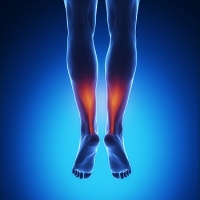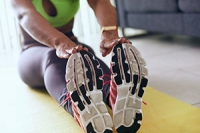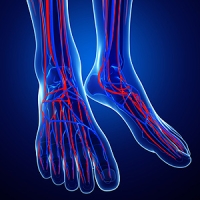
Blog (787)
It’s Time for Beautiful Feet
It's Time for Beautiful Feet
Preventing Running Injuries
Over half of all runners encounter at least one injury per year. The reason for this is because many runners do not train properly. Injuries are almost inevitable due to the physical stress that running causes. While our bodies are great at adapting to the stress, it can only handle it in small doses. Injuries occur when the stress is applied too quickly for the body to handle, causing something within it to break down. With each step you take, your leg is absorbing two or three times your body’s weight.
Some of the most popular running injuries are shin splints, plantar fasciitis, Achilles tendinitis, and stress fractures. Shin splints cause pain along the inside or outside of the shins, and this pain is usually felt at the beginning of a run. The condition itself is defined as an inflammation of the muscles or tendons located around the shinbone. To treat shin splints, it is advised that you ice the shin area and stretch the calf muscles. To prevent this injury, you should slowly increase the distance you plan on running, instead of jumping into a more strenuous routine.
Achilles tendinitis is another common injury and it feels like pain along the back of the leg, toward the heel. This condition is defined as an inflammation of the Achilles which is the largest tendon in the body. The Achilles is responsible for connecting your calf muscles to the heel bone and it is caused by tight calf muscles. If you want to treat this injury, you should take a break from running to cross train with a low-impact activity.
There are a lot of common mistakes runners make that are causing them to experience injury. One mistake is stretching too much prior to warming up. If you plan to go on a run, you should warm up with a gentle 3-5-minute walk followed by a 5-minute run-walk.
Another common mistake is jumping into a routine too quickly. Consequently, you should incorporate cross-training into your routine. If you are looking to get active, you should slowly weave running into an activity you are currently participating in. For example, you can try bike riding for 40 minutes followed by a 10-minute run.
Another way to prevent running injuries is to choose shoes that are appropriate for running. There are certain things you should look for when buying a new pair of running shoes. An important factor in these sneakers is flexibility. Running shoes should be capable of bending and flexing at the forefoot. However, you should not be able to bend the entire shoe in half with ease because this is a sign that the shoe does not have enough structure. Additionally, you should look for the fit of the running shoes you want to purchase. It is best to visit a specialty running shoe store to have your feet properly sized. Choosing shoes that fit properly can prevent many foot ailments.
If you are suffering from any pain from running injuries, you should make an appointment with your podiatrist to discover the underlying cause of your pain. He or she will be able to help treat your condition in the best way possible.
Symptoms Of An Achilles Tendon Injury
The Achilles tendon connects the heel to the calf muscles, and it is located in the back of the leg, directly above the heel. It is known to be the largest tendon in the body, and if it should become injured, it may be difficult to walk and run. This tendon enables the foot to point and flex, in addition to standing on tiptoe. There are noticeable symptoms that exist if an Achilles tendon injury has occurred. These can include severe pain in the back of the leg, the inability to bend the foot, and some patients may also notice the ankle is bruised and weak. As the aging process occurs, it is important to perform proper stretches that can keep the Achilles tendon strong, and this may be helpful in preventing a painful injury from occurring. It can become torn or injured if you suddenly step off of a curb, which may overstretch the tendon. Moderate relief may be found when the affected foot is elevated, and it may feel comforting if an elastic bandage is wrapped around the foot to provide additional support. If you have injured your Achilles tendon, it is advised that you consult with a podiatrist who can properly treat this condition.
Achilles tendon injuries need immediate attention to avoid future complications. If you have any concerns, contact Dr. Kenneth Donovan of Advanced Care Foot and Ankle. Our doctor can provide the care you need to keep you pain-free and on your feet.
What Is the Achilles Tendon?
The Achilles tendon is a tendon that connects the lower leg muscles and calf to the heel of the foot. It is the strongest tendon in the human body and is essential for making movement possible. Because this tendon is such an integral part of the body, any injuries to it can create immense difficulties and should immediately be presented to a doctor.
What Are the Symptoms of an Achilles Tendon Injury?
There are various types of injuries that can affect the Achilles tendon. The two most common injuries are Achilles tendinitis and ruptures of the tendon.
Achilles Tendinitis Symptoms
- Inflammation
- Dull to severe pain
- Increased blood flow to the tendon
- Thickening of the tendon
Rupture Symptoms
- Extreme pain and swelling in the foot
- Total immobility
Treatment and Prevention
Achilles tendon injuries are diagnosed by a thorough physical evaluation, which can include an MRI. Treatment involves rest, physical therapy, and in some cases, surgery. However, various preventative measures can be taken to avoid these injuries, such as:
- Thorough stretching of the tendon before and after exercise
- Strengthening exercises like calf raises, squats, leg curls, leg extensions, leg raises, lunges, and leg presses
If you have any questions please feel free to contact one of our offices located in Warren, Livingston, and Toms River, NJ . We offer the newest diagnostic tools and technology to treat your foot and ankle needs.
The Importance of Warming Up and Cooling Down
The majority of people who enjoy the sport of running and jogging are aware of the importance of properly warming up before beginning their practice. It is important to keep the muscles limber and flexible, and this may be beneficial in preventing running injuries. It is equally as important to perform cool down stretches, and this may be helpful in preventing muscle soreness the following day. Research has indicated it is wise to follow a training plan. This can consist of gradually increasing the mileage and speed of your workout as to avoid strained muscles. Many runners incorporate strength training into their running routine, in addition to cross training activities. If you would like additional information about how running injuries can affect the feet, please consult with a podiatrist.
All runners should take extra precaution when trying to avoid injury. If you have any concerns about your feet, contact Dr. Kenneth Donovan of Advanced Care Foot and Ankle. Our doctor will treat your foot and ankle needs.
How to Prevent Running Injuries
There are a lot of mistakes a runner can make prior to a workout that can induce injury. A lot of athletes tend to overstretch before running, instead of saving those workouts for a post-run routine. Deep lunges and hand-to-toe hamstring pulls should be performed after a workout instead of during a warmup. Another common mistake is jumping into an intense routine before your body is physically prepared for it. You should try to ease your way into long-distance running instead of forcing yourself to rush into it.
More Tips for Preventing Injury
- Incorporate Strength Training into Workouts – This will help improve the body’s overall athleticism
- Improve and Maintain Your Flexibility – Stretching everyday will help improve overall performance
- “Warm Up” Before Running and “Cool Down” Afterward – A warm up of 5-10 minutes helps get rid of lactic acid in the muscles and prevents delayed muscle soreness
- Cross-Training is Crucial
- Wear Proper Running Shoes
- Have a Formal Gait Analysis – Poor biomechanics can easily cause injury
If you have any questions, please feel free to contact one of our offices located in Warren, Livingston, and Toms River, NJ . We offer the newest diagnostic and treatment technologies for all your foot care needs.
The Importance of Warming Up and Cooling Down
 The majority of people who enjoy the sport of running and jogging are aware of the importance of properly warming up before beginning their practice. It is important to keep the muscles limber and flexible, and this may be beneficial in preventing running injuries. It is equally as important to perform cool down stretches, and this may be helpful in preventing muscle soreness the following day. Research has indicated it is wise to follow a training plan. This can consist of gradually increasing the mileage and speed of your workout as to avoid strained muscles. Many runners incorporate strength training into their running routine, in addition to cross training activities. If you would like additional information about how running injuries can affect the feet, please consult with a podiatrist.
The majority of people who enjoy the sport of running and jogging are aware of the importance of properly warming up before beginning their practice. It is important to keep the muscles limber and flexible, and this may be beneficial in preventing running injuries. It is equally as important to perform cool down stretches, and this may be helpful in preventing muscle soreness the following day. Research has indicated it is wise to follow a training plan. This can consist of gradually increasing the mileage and speed of your workout as to avoid strained muscles. Many runners incorporate strength training into their running routine, in addition to cross training activities. If you would like additional information about how running injuries can affect the feet, please consult with a podiatrist.
All runners should take extra precaution when trying to avoid injury. If you have any concerns about your feet, contact Dr. Kenneth Donovan of Advanced Care Foot and Ankle. Our doctor will treat your foot and ankle needs.
How to Prevent Running Injuries
There are a lot of mistakes a runner can make prior to a workout that can induce injury. A lot of athletes tend to overstretch before running, instead of saving those workouts for a post-run routine. Deep lunges and hand-to-toe hamstring pulls should be performed after a workout instead of during a warmup. Another common mistake is jumping into an intense routine before your body is physically prepared for it. You should try to ease your way into long-distance running instead of forcing yourself to rush into it.
More Tips for Preventing Injury
- Incorporate Strength Training into Workouts - This will help improve the body’s overall athleticism
- Improve and Maintain Your Flexibility – Stretching everyday will help improve overall performance
- “Warm Up” Before Running and “Cool Down” Afterward – A warm up of 5-10 minutes helps get rid of lactic acid in the muscles and prevents delayed muscle soreness
- Cross-Training is Crucial
- Wear Proper Running Shoes
- Have a Formal Gait Analysis – Poor biomechanics can easily cause injury
If you have any questions, please feel free to contact one of our offices located in Warren, Livingston, and Toms River, NJ . We offer the newest diagnostic and treatment technologies for all your foot care needs.
Symptoms Of An Achilles Tendon Injury
The Achilles tendon connects the heel to the calf muscles, and it is located in the back of the leg, directly above the heel. It is known to be the largest tendon in the body, and if it should become injured, it may be difficult to walk and run. This tendon enables the foot to point and flex, in addition to standing on tiptoe. There are noticeable symptoms that exist if an Achilles tendon injury has occurred. These can include severe pain in the back of the leg, the inability to bend the foot, and some patients may also notice the ankle is bruised and weak. As the aging process occurs, it is important to perform proper stretches that can keep the Achilles tendon strong, and this may be helpful in preventing a painful injury from occurring. It can become torn or injured if you suddenly step off of a curb, which may overstretch the tendon. Moderate relief may be found when the affected foot is elevated, and it may feel comforting if an elastic bandage is wrapped around the foot to provide additional support. If you have injured your Achilles tendon, it is advised that you consult with a podiatrist who can properly treat this condition.
Achilles tendon injuries need immediate attention to avoid future complications. If you have any concerns, contact Dr. Kenneth Donovan of Advanced Care Foot and Ankle. Our doctor can provide the care you need to keep you pain-free and on your feet.
What Is the Achilles Tendon?
The Achilles tendon is a tendon that connects the lower leg muscles and calf to the heel of the foot. It is the strongest tendon in the human body and is essential for making movement possible. Because this tendon is such an integral part of the body, any injuries to it can create immense difficulties and should immediately be presented to a doctor.
What Are the Symptoms of an Achilles Tendon Injury?
There are various types of injuries that can affect the Achilles tendon. The two most common injuries are Achilles tendinitis and ruptures of the tendon.
Achilles Tendinitis Symptoms
- Inflammation
- Dull to severe pain
- Increased blood flow to the tendon
- Thickening of the tendon
Rupture Symptoms
- Extreme pain and swelling in the foot
- Total immobility
Treatment and Prevention
Achilles tendon injuries are diagnosed by a thorough physical evaluation, which can include an MRI. Treatment involves rest, physical therapy, and in some cases, surgery. However, various preventative measures can be taken to avoid these injuries, such as:
- Thorough stretching of the tendon before and after exercise
- Strengthening exercises like calf raises, squats, leg curls, leg extensions, leg raises, lunges, and leg presses
If you have any questions please feel free to contact one of our offices located in Warren, Livingston, and Toms River, NJ . We offer the newest diagnostic tools and technology to treat your foot and ankle needs.
Can Existing Medical Conditions Cause Poor Circulation?
A common cause of poor circulation is a medical condition known as peripheral artery disease, otherwise known as PAD.
If this develops, the arteries and blood vessels in the legs may become narrow, and it may contribute to decreased blood flow to the legs. Some of the symptoms linked with this ailment can include nerve and tissue damage, and patients may feel tingling and numbing sensations. Research has indicated that there are a variety of reasons why poor circulation may develop. These can include medical conditions such as diabetes, Raynaud’s disease, and obesity may play a significant role in developing poor circulation. Some patients may benefit from wearing compression socks in addition to frequently elevating their feet. This may help to reduce any existing swelling. If you suffer from poor circulation, it is advised that you seek the counsel of a podiatrist who can guide you toward proper treatment options.
Poor circulation is a serious condition and needs immediate medical attention. If you have any concerns with poor circulation in your feet contact Dr. Kenneth Donovan of Advanced Care Foot and Ankle. Our doctor will treat your foot and ankle needs.
Poor Circulation in the Feet
Poor blood circulation in the feet and legs is can be caused by peripheral artery disease (PAD), which is the result of a buildup of plaque in the arteries.
Plaque buildup or atherosclerosis results from excess calcium and cholesterol in the bloodstream. This can restrict the amount of blood which can flow through the arteries. Poor blood circulation in the feet and legs are sometimes caused by inflammation in the blood vessels, known as vasculitis.
Causes
Lack of oxygen and oxygen from poor blood circulation restricts muscle growth and development. It can also cause:
- Muscle pain, stiffness, or weakness
- Numbness or cramping in the legs
- Skin discoloration
- Slower nail & hair growth
- Erectile dysfunction
Those who have diabetes or smoke are at greatest risk for poor circulation, as are those who are over 50. If you have poor circulation in the feet and legs it may be caused by PAD and is important to make changes to your lifestyle in order to reduce risk of getting a heart attack or stroke. Exercise and maintaining a healthy lifestyle will dramatically improve conditions.
As always, see a podiatrist as he or she will assist in finding a regimen that suits you. A podiatrist can also prescribe you any needed medication.
If you have any questions please feel free to contact one of our offices located in Warren, Livingston, and Toms River, NJ . We offer the newest diagnostic and treatment technologies for all your foot and ankle needs.
Read more about Causes, Symptoms, and Treatment of Poor Blood Circulation in the Feet
Can Existing Medical Conditions Cause Poor Circulation?
A common cause of poor circulation is a medical condition known as peripheral artery disease, otherwise known as PAD. If this develops, the arteries and blood vessels in the legs may become narrow, and it may contribute to decreased blood flow to the legs. Some of the symptoms linked with this ailment can include nerve and tissue damage, and patients may feel tingling and numbing sensations. Research has indicated that there are a variety of reasons why poor circulation may develop. These can include medical conditions such as diabetes, Raynaud’s disease, and obesity may play a significant role in developing poor circulation. Some patients may benefit from wearing compression socks in addition to frequently elevating their feet. This may help to reduce any existing swelling. If you suffer from poor circulation, it is advised that you seek the counsel of a podiatrist who can guide you toward proper treatment options.
Poor circulation is a serious condition and needs immediate medical attention. If you have any concerns with poor circulation in your feet contact Dr. Kenneth Donovan of Advanced Care Foot and Ankle. Our doctor will treat your foot and ankle needs.
Poor Circulation in the Feet
Poor blood circulation in the feet and legs is can be caused by peripheral artery disease (PAD), which is the result of a buildup of plaque in the arteries.
Plaque buildup or atherosclerosis results from excess calcium and cholesterol in the bloodstream. This can restrict the amount of blood which can flow through the arteries. Poor blood circulation in the feet and legs are sometimes caused by inflammation in the blood vessels, known as vasculitis.
Causes
Lack of oxygen and oxygen from poor blood circulation restricts muscle growth and development. It can also cause:
- Muscle pain, stiffness, or weakness
- Numbness or cramping in the legs
- Skin discoloration
- Slower nail & hair growth
- Erectile dysfunction
Those who have diabetes or smoke are at greatest risk for poor circulation, as are those who are over 50. If you have poor circulation in the feet and legs it may be caused by PAD and is important to make changes to your lifestyle in order to reduce risk of getting a heart attack or stroke. Exercise and maintaining a healthy lifestyle will dramatically improve conditions.
As always, see a podiatrist as he or she will assist in finding a regimen that suits you. A podiatrist can also prescribe you any needed medication.
If you have any questions please feel free to contact one of our offices located in Warren, Livingston, and Toms River, NJ . We offer the newest diagnostic and treatment technologies for all your foot and ankle needs.
Why Do Ingrown Toenails Develop?
When a toenail grows into the skin instead of over it, it’s referred to as an ingrown toenail. Ingrown toenails generally cause severe pain and discomfort, and shoes may become difficult to wear. Some associated symptoms include pus draining from the sides of the nail and the surrounding skin turning red and swollen. Common reasons why ingrown toenails develop include trimming the toenail incorrectly, wearing shoes and socks that are too tight, or an injury that has occurred to the toe. Patients who have this ailment may find moderate relief when the toe is soaked in warm water. This helps soften the skin around the nail. If the area becomes infected, seek the counsel of a podiatrist who can properly treat ingrown toenails.
Ingrown toenails may initially present themselves as a minor discomfort, but they may progress into an infection in the skin without proper treatment. For more information about ingrown toenails, contact Dr. Kenneth Donovan of Advanced Care Foot and Ankle. Our doctor can provide the care you need to keep you pain-free and on your feet.
Ingrown Toenails
Ingrown toenails are caused when the corner or side of a toenail grows into the soft flesh surrounding it. They often result in redness, swelling, pain, and in some cases, infection. This condition typically affects the big toe and may recur if it is not treated properly.
Causes
- Improper toenail trimming
- Genetics
- Improper shoe fitting
- Injury from pedicures or nail picking
- Abnormal gait
- Poor hygiene
You are more likely to develop an ingrown toenail if you are obese, have diabetes, arthritis, or have any fungal infection in your nails. Additionally, people who have foot or toe deformities are at a higher risk of developing an ingrown toenail.
Symptoms
Some symptoms of ingrown toenails are redness, swelling, and pain. In rare cases, there may be a yellowish drainage coming from the nail.
Treatment
Ignoring an ingrown toenail can have serious complications. Infections of the nail border can progress to a deeper soft-tissue infection, which can then turn into a bone infection. You should always speak with your podiatrist if you suspect you have an ingrown toenail, especially if you have diabetes or poor circulation.
If you have any questions, please feel free to contact one of our offices located in Warren, Livingston, and Toms River, NJ . We offer the newest diagnostic and treatment technologies for all your foot care needs.












